


|
|
|
IF you want to eat a meal that is 100 per cent Persian, you don�t have to go all the way to Iran to do that. Figure out, instead, how to wrangle an invitation to the warm and cosy home of Khorshed and Moti Irani of Dahanu. They are a lovely, hospitable couple. And when they entertain guests from outstation, as they frequently do, then these Iranis make sure the dining is authentic Persian food. Which is vastly different from regular Parsi-Irani food. I broke bread with them, literally, when I travelled to the coastal town. Khorshed and Moti Irani are horticulturists and bakers. They have chikoo wadis and coconut trees. And Khorshed is in partnership with Firdaus Irani, also of Dahanu, in the popular Agnee Bakery in the town and in nearby Vapi. They have two sons, Dr. Yohan Ragaby, a successful dental surgeon married to Fraynaz, a pretty Iranian girl of Bombay origin, and Zarathusht Ragaby, who is also a baker.
But to come to the lunch, it was prepared in the Iranis�s modern kitchen by Moti and her maid, on very 21st century equipment. And, it was as diverse as these wonderful people whose ancestors came from Persia. Intrigued by the preparations, I asked for the menu before we sat down to the meal. And this is what it read like, to my great astonishment: Korma bhaji, Survokhiya, Berry Pulao, Oushebreng, and Gusthebherun. Which sounded as unlike Dhansak and Mutton Sali Boti as can be.
I will start with the Khorma bhaji. It is not a dish of vegetables as you might imagine. This bhaji also has meat. And it is not so much a korma as much as a thick broth. Moti explained: �In Iran, the climate is always cold, so the people like to have something soupy that is warm and nourishing. The Khorma bhaji is it. The Iranis of Dahanu get the bhaji from Iran. It is kid beans, a kind of lentil and methi. The veggies are soaked in water and cooked with meat. Very tasty and very filling. I believe in Iran, this dish is sometimes called Khoresh.
The Berry pulao, I have had before. It is the best-selling item on an Iranian menu in Bombay�s popular Britannia Restaurant where I dine frequently. In Moti Irani�s kitchen, a pan that had been greased with ghee was layered with rice, then with potatoes, and then rice again. She cooked this pulao and garnished it with the berries she had acquired from Iran. The pulao is a slightly sourish rice dish. Iranis eat a lot of rice. One of their most popular dishes, but which was not on the menu that afternoon, is the Chello-Kebab, a combination of steamed rice, fillet kebabs, butter, yolk of eggs, tomatoes grilled over charcoal, white onions, herbs, and a simple pickle known as the toorshi.
And, finally at Khorshed and Moti Irani�s home, I had the Gusthebherun, which was kid lamb cooked with potato, onion, ginger, whole pepper, dry red chillies, tej patta, salt and pepper. It is pressure cooked in little water. When removed, the lamb can be carved up very easily. Very strangely, the Iranis were consuming the Gusthebherun like a snack. In between the meal, this Irani family kept helping itself to the brun pav sliced and kept on the table. �It is a very Irani habit,� said Moti. And they served me a bread pudding from their Agnee Bakery for dessert, flavoursome with cardamom. But what I thought really was a Persian habit was the small ball of dehydrated camel�s milk that Moti had got from Iran that she used in her cooking. �It is preserved in salt and used as a garnish for our food,� she said. �But this is an acquired taste, its can remind you of goat�s cheese, but is much more sour. Camel�s milk is hard to get, but it remind us of Iran.�
|

Home Page
About the mag
Subscribe
Advertise
Contact Us

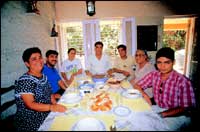 In Dahanu,They Eat Persian Food!
In Dahanu,They Eat Persian Food!
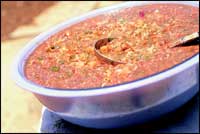 The Iranis had a story to tell about why their sons bore a different surname. Rugaby is the name of their native village in Iran. And it is common practise for Iranians coming from this village to take the surname Rugaby. However, Khorshed and Moti changed their boys� surname because there was the fear during the great Iraq-Iran war of the 1980s that even Indians with the surname �Irani� faced persecution during their travels abroad.
The Iranis had a story to tell about why their sons bore a different surname. Rugaby is the name of their native village in Iran. And it is common practise for Iranians coming from this village to take the surname Rugaby. However, Khorshed and Moti changed their boys� surname because there was the fear during the great Iraq-Iran war of the 1980s that even Indians with the surname �Irani� faced persecution during their travels abroad.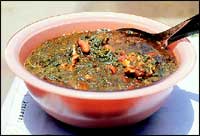 I believe there is no one dish that typifies the cuisine. Persian food is known for its variety and innovation. And its complexity and richness. No meal is ever predictable. Different flavours and textures are blended together. Like rice is combined with saffron, fresh fruit with meat or chicken, and the subtle flavours of vegetables cooked in meats could be served along with rich, appetising and unusual soups. �Be prepared to be adventurous,� Moti said to be as we sat at the dining table.
I believe there is no one dish that typifies the cuisine. Persian food is known for its variety and innovation. And its complexity and richness. No meal is ever predictable. Different flavours and textures are blended together. Like rice is combined with saffron, fresh fruit with meat or chicken, and the subtle flavours of vegetables cooked in meats could be served along with rich, appetising and unusual soups. �Be prepared to be adventurous,� Moti said to be as we sat at the dining table.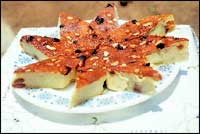 The Survokhiya, however, is the actual soup. Survo means soup in Persian. And it is an egg soup, made with flour (�channa ke atta,� said Moti) and fried onions. It is a type of quiche. The egg is beaten in right at the end. Though they served it to me for lunch, the Survokhiya, Moti said, is actually a breakfast dish in Iran. It is had with a thickish naan. �This is like a dish you will find in Jewish cuisine,� my informative host said to me helpfully. They do other versatile soups in Iran even today. Like the Dolmeh, which is stuffed vegetables and leaves, as well as fruits such as apples and quince.
The Survokhiya, however, is the actual soup. Survo means soup in Persian. And it is an egg soup, made with flour (�channa ke atta,� said Moti) and fried onions. It is a type of quiche. The egg is beaten in right at the end. Though they served it to me for lunch, the Survokhiya, Moti said, is actually a breakfast dish in Iran. It is had with a thickish naan. �This is like a dish you will find in Jewish cuisine,� my informative host said to me helpfully. They do other versatile soups in Iran even today. Like the Dolmeh, which is stuffed vegetables and leaves, as well as fruits such as apples and quince.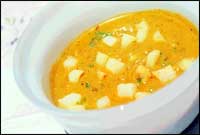 The Oushebreng, on the other hand, is another rice dish, but this one is a hodge-podge, it is made with red beans, chana, mung, brown mung, masoor dal, broken wheat. The mixture is soaked overnight, then cooked with meat, salt and pepper is added, then rice, onions, coriander. It is a whole meal in itself. �You don�t need a side dish when you are serving Oushebreng to your family,� said Moti. Iranis also make pulaos combining different meats and beans. Their Morg Polo is a rice and chicken dish. Tahchin is a rich combination of rice and lamb combined with saffron and eggs.
The Oushebreng, on the other hand, is another rice dish, but this one is a hodge-podge, it is made with red beans, chana, mung, brown mung, masoor dal, broken wheat. The mixture is soaked overnight, then cooked with meat, salt and pepper is added, then rice, onions, coriander. It is a whole meal in itself. �You don�t need a side dish when you are serving Oushebreng to your family,� said Moti. Iranis also make pulaos combining different meats and beans. Their Morg Polo is a rice and chicken dish. Tahchin is a rich combination of rice and lamb combined with saffron and eggs.